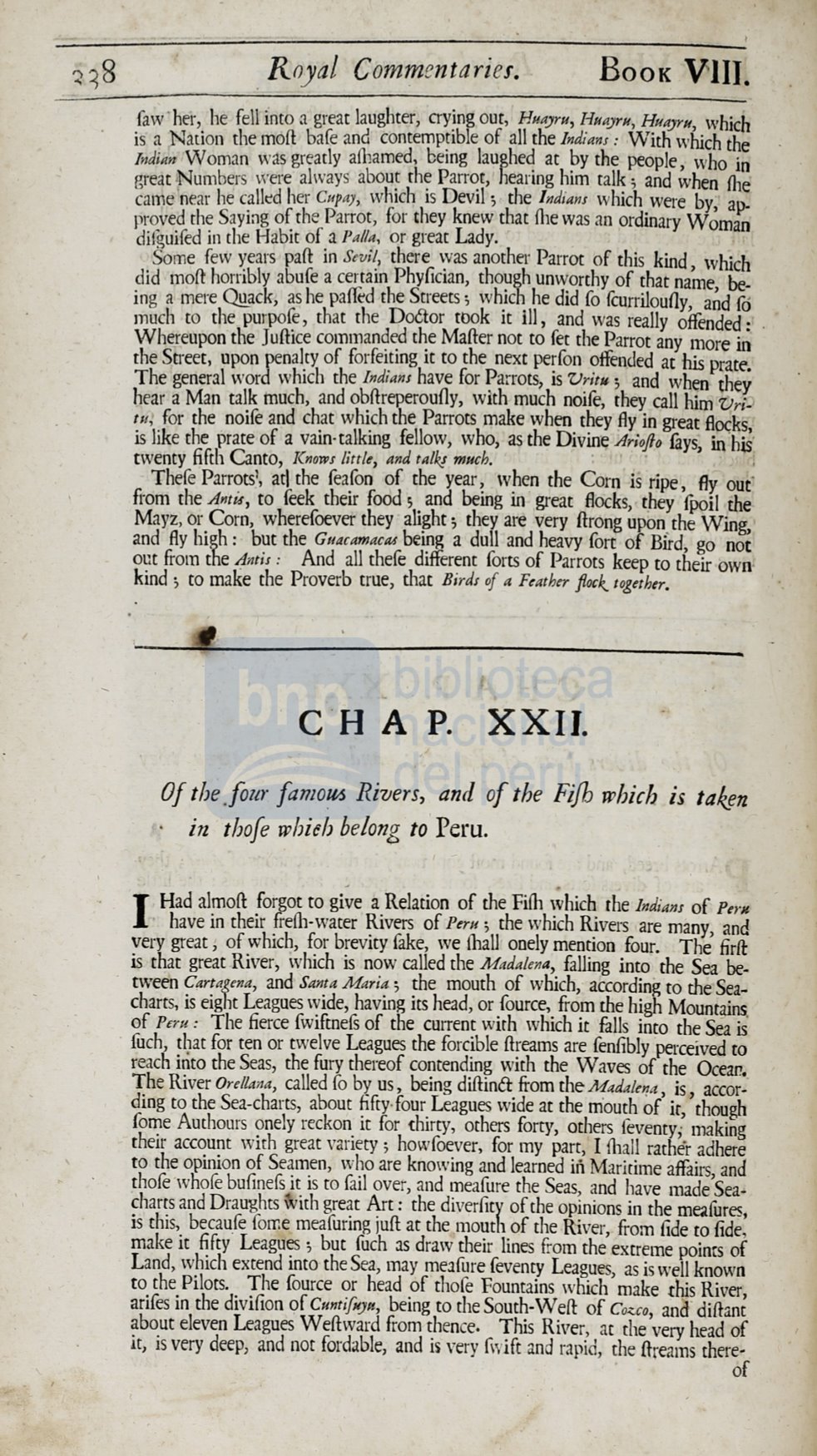

Royal Commentaries.
BooK
VIII.
faw "her he fell into a great laughcer, crying out,
Huayru, Huayru, Huayru,
which
is a ,ll'-fa~ion che m0íl: ba[e and toncemp~ible of al! the
lndíans:
-With which the
Jndiaw
Woman wás greatly aíbamed, bemg laughe~ at ~y the people, who in
great Numbers were always abou~ ch~ Parr~t, hearmg h1m cal½; and when
íhe
came
1
near he called her
Cupay,
wh1ch 1s Dev1l; che
lndians
which_were by;· ap–
proved che Saying o~ the Parrot, for they knew tbac íhe was an ordmary
W
ornan
difgui[ed in che Hab1t of a
Palla,
or greac Lady.
Sorne few years paíl: in
Sevil,
there was another Parrot of chis kind , which
did moft horribly abu[e a certain Phyfician, though unworthy of thac name
be–
ing a mere O!l_ack, as he paffed che Screecs ; which he did
fo
fcurrilouíly, a~d
[ó
much
co
the purpo[e, that the Doétor t0ok it
ill,
and was really offended :
Whe;eupon·che
J
uíl:ice comman1~d t~e Mafier not to fer che Parrot any more
in
the Street, upon penalty of forfenmg 1c to che next perfon offended at
his
prate.
The general word which che
Indians
have for ~arrots, is
V~itu;
and wbe,n they
hear a Man talk tnuch, and obfireperouíly, w1th much no1fe, they call him
Vri
u,,
for che noife and chac which che Parrots ,make when they fly in greac flP<;ks,
is like the prate of a vain-talking fellow, who, as che Divin~
Ariofto
fays, in his
cwency fifth Canto,
ICnows
little, and t11lk¿
much.
·
·
The[e Parrots1, acl che [eafon of che year, when che Corn is ripe,
fly
out
from che
Antu,
·co feek their food
s
and being in great flocks, c_hey
fpoil
che
Mayz, or Corn, wherefoever they alight; they are very íl:rong upon.che Wing, '
and fly high: bue che
GuacamactU
being a dull and heavy fort of Bird, go not
out from che
Antis :
And al! thefe differenc forts of Parrots keep
to
cheir own·
kind ;
to
make che Proverb true, that
Birds of a Feather
flock_
togerher.
XXII.
Of
the
.four famoU5
Rivers,
and
of
the
Fifb
which
1s
ta1<_en
in thofe whieh belong to
Peru.
I
Had almoíl: forgot to gi~e a Relacion of che
Fiíh
which the
Jndians
of
Pm,
have in their freíh-wacer Rivers of
Peru;
che which Rivers are many, and
very great, of which, for brevity fake, we !hall onely mencion four. The
firft
is
chat great River, which is now called che
M adalena,
falling into che Sea
be–
tween
Cflrtagena,
and
Santa M aria ;
che mouth of which, according to the Sea–
charts, is eight Leagues wide, having its head, or fource, from the high Mount~ins.
of
Peru:
The fierce [wifmefs of che current with which it falls into the &ea
is
füch., thac for ten or twe\ve Leagues che forcible fireams are fenfibly perceíved
to
reactl irito che Seas, che fury thereof concending wich che Waves of the Ocear..
The River
Ore/lana,
called fo by us, being diíl:inlt from the
Madalel'fa ,
is, accor–
ding to che Sea-charts, about fifty.four Leagues wide at che triouth of ir, chough
fome Auchours onely reckon it for {hircy, ochers forcy, others fevency; making
their account wich greacvariecy; howfoever, for my pare,
I
íhall rather adhere
to the opinion of Seamen, who are knowing and leamed iñ Maricime affairs, and
thofe ·whofe bufinefs it is to fail over, and meafure che Seas, and have made Sea–
charts and Draughcs with great Are: che diverfity ofche opinions in the me.ifüres,
is chis, becaufe fome meafüring juíl: at che mouth of che River, from fide
to
fide,
make it
fifty'
Leagues; bue fuch as draw their lines from the extreme poinrs of
Land, which extend inco the Sea, may me.1füre fevency Leagu€s, as iswell known
to che Pilocs. The fource or head of chofe Fountains which make this River,
ari[es in che divifion of
Cuntifuyu,
being to che South-Wefi of
Co;;:,co,
arnl dillant
about eleven Leagues Weíl:ward from thence. This River, ac the very head of
lt,
is very deep, and noc fordable, and is very faift and
rapid,
che fireams chere-
of














